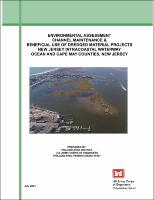Please use this identifier to cite or link to this item:
https://hdl.handle.net/11681/37595| Title: | Environmental Assessment : Channel Maintenance & Beneficial Use of Dredged Material Projects, New Jersey Intracoastal Waterway, Ocean and Cape May Counties, New Jersey |
| Authors: | United States. Army. Corps of Engineers. Philadelphia District |
| Keywords: | New Jersey Intracoastal waterways Dredging Dredging spoil Environmental protection Environmental management |
| Publisher: | United States. Army. Corps of Engineers. Philadelphia District. |
| Abstract: | Funding for maintenance of the NJIWW has been limited in recent years. However, as a result of Hurricane Sandy impacts, funding to dredge critical shoals in the NJIWW was made available under P.L. 113-2: Disaster Relief Appropriations Act (FY 2013) - Operations and Maintenance (O&M) Emergency Supplemental. A lease-of-plant maintenance dredging contract was awarded to Barnegat Bay Dredging Company to address impacted areas in the waterway and work to restore the channel in sections identified as having critical shoals. The Mordecai Island, Avalon and Stone Harbor areas have been identified as critical shoal locations with dredged material placement sites that would restore degraded coastal habitats. Beneficial use of the NJIWW material to prevent further loss of eroding habitats is an optimum regional sediment management solution for the issues in the NJIWW. Saltwater marshes on the New Jersey coastline have been disappearing over the past hundred years due to factors such as sea level rise, lower accretion rates, and higher rates of anthropogenic erosion. In the Avalon project area alone, it is estimated that over 120 acres of coastal marsh has been lost since the 1930’s. As sea levels continue to rise and storms become more frequent and intense, salt marshes that cannot keep pace with sea level rise will ultimately be lost along with the ecosystem services they provide to coastal communities and the coastal economy. Furthermore, salt marshes provide habitat for economically and ecologically important fish, crabs, and shellfish; nesting and foraging habitat for migratory and resident birds; and improve water quality through de-nitrification and sediment removal. Beneficial reuse projects like these will create a regional uplift in ecosystem functions, services and resiliency—including increased buffering capacity against storm and flood damage, significant regional uplift in water quality, and the enhancement and creation of fish, shellfish, wading bird, and waterfowl habitat. The uplift in ecosystem services will have a significant, positive impact on dependent local and regional economies including tourism, hunting, fishing, recreation, and avoided storm damage costs. |
| Description: | Environmental Assessment |
| Rights: | Approved for Public Release; Distribution is Unlimited |
| URI: | https://hdl.handle.net/11681/37595 |
| Appears in Collections: | Environmental Documents |
Files in This Item:
| File | Description | Size | Format | |
|---|---|---|---|---|
| NJIWW_2014_EA.pdf | 7.65 MB | Adobe PDF |  View/Open |